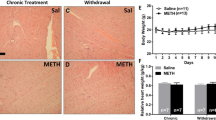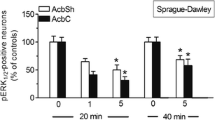Abstract
We previously demonstrated that morphine withdrawal induced hyperactivity of the heart by activation of noradrenergic pathways innervating the left and right ventricle, as evaluated by noradrenaline (NA) turnover and Fos expression. The present study was designed to investigate the role of protein kinase C (PKC) in this process, by estimating whether pharmacological inhibition of PKC would attenuate morphine withdrawal induced Fos expression and changes in tyrosine hydroxylase (TH) immunoreactivity levels and NA turnover in the left and right ventricle. Dependence on morphine was induced on day 8 by an injection of naloxone. Morphine withdrawal induced Fos expression and increased TH levels and NA turnover in the right and left ventricle. Infusion of calphostin C, a selective PKC inhibitor, did not modify the morphine withdrawal-induced increase in NA turnover and TH levels. However, this inhibitor produced a reduction in the morphine withdrawal-induced Fos expression. The results of the present study provide new information on the mechanisms that underlie morphine withdrawal-induced up-regulation of Fos expression in the heart and suggest that TH is not a target of PKC during morphine withdrawal at heart levels.




Similar content being viewed by others
References
Aanta R, Marjamäki A, Scheinin M (1995) Molecular pharmacology of alpha2-adrenoceptor subtypes. Ann Med 27:439–449
Armour JA (1991) Intrinsic cardiac neurons. J Cardiovasc Electrophysiol 2:331–341
Benavides M, Laorden ML, Milanés MV (2003) Regulation of tyrosine hydroxylase levels and activity and Fos expression during opioid withdrawal in the hypothalamic PNV and medulla oblongata catecholaminergic cell groups innervating the PVN. Eur J Neurosci 17:103–112
Benavides M, Laorden ML, Marin MT, Milanés MV (2005) Role of PKC-α,γ isoforms in regulation of c-fos and TH expression after naloxone-induced morphine withdrawal in the hypothalamic PVN and medulla oblongata catecholaminergic cell groups. J Neurochem 95:1249–1258
Berhow MT, Russel DS, Terwilliger RZ, Beitner-Johnson D, Self DW, Lindsay RM, Nestler EJ (1995) Influence of neuortrophic factors on morphine- and cocaine-induced biochemical changes in the mesolimbic dopamine system. Neuroscience 68:969–979
Boundy VA, Gold SJ, Messer CJ, Chen J, Son JH, Hoh TH, Nestler EJ (1998) Regulation of tyrosine hydroxylase promoter activity by chronic morphine in TH9.0-lacZ transgenic mice. J Neurosci 18:9989–9995
Busquets X, Escribá PV, Sastre M, García-Sevilla JA (1995) Loss of protein kinase C-alphaBeta in brain of heroin addicts and morphine-dependent rats. J Neurochem 64:247–252
Cerezo M, Laorden ML, Milanés MV (2002) Inhibitioin of protein kinase C but not protein kinase A attenuates morphine withdrawal excitation of rat hypothalamus-pituitary-adrenal axis. Eur J Pharmacol 452:57–66
Cerezo M, Milanés MV, Laorden ML (2005) Alterations in protein kinase A and different protein kinase C isoforms in the heart during morphine withdrawal. Eur J Pharmacol 522:9–19
Curran E, Akil H, Watson S (1996) Psychomotor stimulant-and opiate-induced c-fos mRNA expression patterns in the rat forebrain:comparisons between acute drug treatment and a drug challenge in sensitised animals. Neurochem Res 21:1425–1435
Fundytus ME, Coderre TJ (1996) Chronic enhibition of intracellular Ca** release of protein kinase C activation significantly reduces the development of morphine dependence. Eur J Pharmacol 300:173–181
Gizang E, Ziff EB (1994) Fos family members successively occupy the tyrosine hydroxylase gene AP-1 site after nerve growth factor or epidermal growth factor stimulation and can repress transcription. Mol Endocrinol 8:249–262
González-Cuello A, Milanés MV, Castells MT, Laorden ML (2003) Activation c-fos expression in the heart after morphine but not U-50,488H withdrawal. Br J Pharmacol 138:626–633
González-Cuello A, Milanés MV, Avíles M, Laorden ML (2004a) Changes in c-fos expression in the rat heart during morphine withdrawal. Involvement of a2-adrenoceptors. Naunyn-Schmiedeberg’s Arch Pharmacol 370:17–25
González-Cuello A, Milanés MV, Castells MT, Laorden ML (2004b) Morphine-withdrawal induced c-fos expression in the heart: a peripheral mechanism. Eur J Pharmacol 487:117–124
González-Cuello A, Milanés MV, Laorden ML (2004c) Increase of tyrosine hydroxylase levels and activity during morphine withdrawal in the heart. Eur J Pharmacol 506:119–128
Granados-Soto V, Kalcheva I, Hua XY, Newton A, Yaksh TL (2000) Spinal PKC activity and expression: role in tolerance produced by continous spinal morphine infusion. Pain 85:395–404
Hannan RD, Stennard FA, West AK (1993) Expression of c-fos and related genes in the rat heart in response to norepinephrine. J Mol Cell Cardiol 25:1137–1148
Haykock JW (1993) Multiple signaling pathways in bobine chromaffin cells regulate tyrosine hydroxylase phosphorylation at ser19, ser31 and ser40. Neurochem Res 18:15–26
Kobayashi E, Nakano H, Morimoto M, Tamaoki T (1989) Calphostin C (UCN), a novel microbial compound, is a highy potent and specific inhibitor of protein kinase C. Biochem Biophys Res Commun 159:548–553
Koya D, Jirosek MR, Lin Y-W, Ishi H, Kuboki K, King GL (1997) Characteristics of protein kinase CBeta isoform activation on the gene expression of transforming growth factor Beta, extracellular matrix components and prostanoids in the flomeruli of diabetic rats. J Clin Invest 100:115–126
Kramer HK, Simon EJ (1999) Role of protein kinase C (PKC) in agonist-induced mu-opioid receptor down-regulation: I. PKC translocation to the membrane of SH-SY5Y neuroblastoma cells is induced by mu-opioid agonists. J Neurochem 72:585–593
Laorden ML, Castells MT, Martínez MD, Martínez PJ, Milanés MV (2000) Activation of c-fos expression in hypothalamic nuclei by mu-and kappa-receptor agonists. Correlation with catecholaminergic activity in the hypothalamic paraventricular nucleus. Endocrinology 141:1366–1376
Laorden ML, Castells MT, Milanés MV (2002a) Effects of morphine and morphine withdrawal on brainstem neurons innervating hypothalamic nuclei that control the pituitary-adrenocortical axis in rats. Br J Pharmacol 136:67–75
Laorden ML, Nuñez C, Almela P, Milanés MV (2002b) Morphine withdrawal-induced c-fos expression in the hypothalamic paraventricular nucleus is dependent on the activation of catecholaminergic neurones. J Neurochem 83:132–140
Liu JG, Anand KJ (2001) Protein kinases modulate the cellular adaptations associated with opioid tolerance and dependence. Brains Res Rev 38:1–19
Lynch JJ, Ferro TJ, Blumenstock FA, Brockenauer AM, Malik AM (1990) Invreased endothelial albumin permeability mediated by protein kinase C activation. J Clin Invest 85:1991–1998
Maldonado R (1997) Participation of noradrenergic pathways in the expression of opiate withdrawal: biochemical and pharmacological evidence. Neurosci Biobehav Rev 1:91–104
Martínez MD, Milanés MV, Laorden ML (2003) Implication of the signal transduction pathways in the enhancement of noradrenaline turnover induced by morphine withdrawal in the heart. Eur J Pharmacol 471:113–119
Milanés MV, Laorden ML (2000) Changes in catecholaminergic pathways innervating the rat heart ventricle during morphine dependence. Involvement of alpha1 and alpha2 adrenoreceptors. Eur J Pharmacol 397:311–318
Milanés MV, Martínez MD, González-Cuello A, Laorden ML (2001) Evidence for a peripheral mechanism in cardiac opioid withdrawal. Naunyng-Schmiedeberg’s Arch Pharmacol 364:193–198
Milanés MV, Fuente T, Laorden ML (2000) Catecholaminergic activity and 3′,5′-cyclic adenosine monophosphate levels in heart right ventricle after naloxone induced withdrawal. Naunin-Schmiedeberg’s Arch Pharmacol 361:61–66
Mizukami Y, Yoshida K (1997) Mitogen-activated prokinase translocates to the nucleus during ischaemia and activated during reperfusion. Biochem J 323:785–790
Morales L, Pérez-García C, Aguacil LF (2001) Effects of yohimbine on the antinociceptive and place conditioning effects of opioid agonists in rodents. Br J Pharmacol 133:172–178
Morgan JI, Curran T (1991) Stimulus transcription coupling in the nervous system: involvement of the inducible proto-oncogenes fos and jun. Ann Rev Neurosci 14:421–451
Narita M, Makimura M, Feng Y, Hoskins B, Ho IK (1994) Influence of chronic morphine treatment on protein kinase C activity:comparison with butorphanol and implication for opioid tolerance. Brain Res 650:175–179
Naruse K, King GL (2000) Protein kinase C and myocardial biology and function. Circ Res 86:1104–1106
Nestler EJ (1992) Molecular mechanism of drug addiction. J Neurosci 278:58–63
Nestler EJ, Aghajanian CK (1997) Mollecular and cellular basis of addiction. Science 278:58–63
Nishizuka Y (1995) Protein kinase C and lipid signaling for sustained cellular responses. FASEB J 9:484–496
Rabadán JV, Milanés MV, Laorden ML (1997) Effects of chronic morphine treatment on catecholamines content and mechanical response in the rat heart. J Pharmacol Exp Ther 280:32–37
Rabadán JV, Milanés MV, Laorden ML (1998) Changes in right atria catecholamines content in naive rats and after naloxone-induced withdrawal. Br J Anaesth 80:354–359
Singh S, Johson PI, Javed A, Gray TS, Lonchyna VA, Wurster RD (1999) Monoamine- and histamine-synthesizing enzymes and neurotransmitters within neurons of adult human cardiac ganglia. Circulation 99:411–419
Smart D, Lambert DG (1996) The stimulatory effects of opioids and their possible role in the development of tolerance. Trends Pharmacol Sci 17:264–269
Taylor JR, Lewis JD, Elsworth JC, Charney DS, Jablons DR, Roth RH, Redmond DE, Maas JW (1991) Yohimbine co-treatment during chronic morphine administration attenuates naloxone precipitated withdrawal without diminishing tail-lick analgesia in rats. Psychopharmacology 103:407–414
Thompson GW, Ardell JL, Murphy DA, Sangalang VE, Stevenson R, MaCraty R, Armour JA (1999) Neural control of the autotransplanted heart. FASEB J 13:A446
Tokuyama S, Feng Y, Wakabayashi H, Ho IK (1995) Possible involvement of proteinkinases in physical dependence on opioids: studies using protein kinase inhibitors, H–7 and H–8. Eur J Pharmacol 284:101–107
Ueyama T, Umemoto S, Senba E (1996) Immobilization stress induces c-fos and c-jun immediate early genes expression in the heart. Life Sci 59:339–347
Ueyama T, Yoshida KI, Senba E (1999) Emotional stress induced immediate-early gene expression in rat heart via activation of alpha and beta-adrenoceptors. Am J Physiol 277:H1553–H1561
Wiechelman KJ, Braund RD, Fitzpatrick JD (1988) Investigation of the bicincinomic acid protein assay:identification of the groups responsible for colour formation. Anal Biochem 175:231–237
Williams JT, Christie MJ, Manzoni O (2001) Cellular and synaptic adaptations mediating opioid dependence. Physiol Rev 81:299–343
Acknowledgements
This work was supported by Ministerio de Ciencia y Tecnología (SAF/FEDER 2002–00763, 2003–00756) and Ministerio del Interior, Madrid Spain.
Author information
Authors and Affiliations
Corresponding author
Rights and permissions
About this article
Cite this article
Almela, P., Cerezo, M., Milanés, M.V. et al. Role of PKC in regulation of Fos and TH expression after naloxone induced morphine withdrawal in the heart. Naunyn Schmied Arch Pharmacol 372, 374–382 (2006). https://doi.org/10.1007/s00210-006-0032-y
Received:
Accepted:
Published:
Issue Date:
DOI: https://doi.org/10.1007/s00210-006-0032-y




